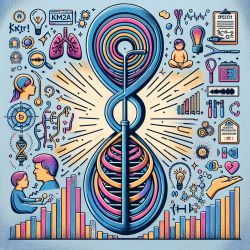Introduction
In the ever-evolving world of genetic research, the discovery of novel mutations and their implications can significantly impact clinical practices. Wiedemann-Steiner Syndrome (WDSTS) is a rare genetic disorder that has been increasingly recognized due to advancements in genetic testing, such as whole exome sequencing (WES). A recent case study published in Medicine (Baltimore) highlights a new de novo mutation in the KMT2A gene, expanding our understanding of WDSTS and its phenotypic spectrum.
Understanding Wiedemann-Steiner Syndrome
WDSTS is characterized by distinct facial features, developmental delays, and behavioral challenges. The syndrome is linked to mutations in the KMT2A gene, which plays a crucial role in gene expression regulation during development. This case study presents a Chinese boy who was initially misdiagnosed due to overlapping features with Blepharophimosis-Ptosis-Epicanthus Inversus Syndrome (BPES). The discovery of a unique frameshift mutation in the KMT2A gene led to a correct diagnosis of WDSTS.
Clinical Implications for Practitioners
For practitioners, this case underscores the importance of considering genetic testing when traditional diagnostic methods fall short. Whole exome sequencing can be a powerful tool in identifying rare genetic disorders, offering a clearer picture of the genotype-phenotype relationship. Practitioners should be aware of the following when dealing with potential WDSTS cases:
- Consider WES for patients with atypical presentations or when initial genetic tests are inconclusive.
- Be vigilant for overlapping syndromic features that may lead to misdiagnosis.
- Collaborate with genetic counselors to provide comprehensive care and guidance for affected families.
Enhancing Therapeutic Outcomes
For children diagnosed with WDSTS, early intervention and tailored therapeutic strategies are vital. Speech and occupational therapy can significantly improve communication skills and overall development. The case study revealed that the patient showed marked improvement in expressive abilities following regular therapy sessions. Practitioners should focus on:
- Implementing individualized therapy plans that address specific developmental delays.
- Encouraging multidisciplinary approaches involving speech therapists, occupational therapists, and educators.
- Monitoring growth and development closely, considering growth hormone therapy if indicated.
Encouraging Further Research
As our understanding of WDSTS and its genetic underpinnings grows, further research is essential to uncover additional mutations and refine therapeutic approaches. Practitioners are encouraged to contribute to genetic databases and collaborate in research efforts to expand the knowledge base of this rare syndrome.
Conclusion
The identification of a new KMT2A mutation in WDSTS highlights the importance of genetic testing in achieving accurate diagnoses and optimizing patient outcomes. Practitioners must stay informed about the latest genetic discoveries and incorporate these insights into their clinical practice. By doing so, we can pave the way for better care and improved quality of life for children with WDSTS.
To read the original research paper, please follow this link: Wiedemann-steiner syndrome with a de novo mutation in KMT2A.










